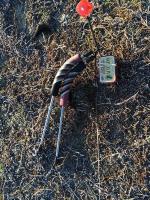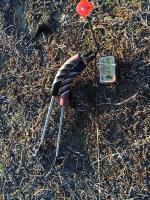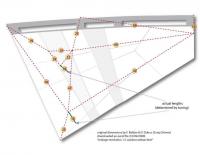-
Posts
818 -
Joined
-
Last visited
-
Days Won
42
Content Type
Profiles
Forums
Gallery
Downloads
KL Shop
Blogs
Articles
Everything posted by Paul LaMasters
-
Shook mesh masterpieces offer the wind range of 1-1/2 to 2 normally vented wings, two kites for less than that price is why over 300 have been individually ordered. It should NOT work as well as it does! The most popular model is situated exactly btwn a full and mid-vent,.... what does that mean? A Shook 75% is almost always the right kite. During a large gathering you'd see all the models being flown together, not in compromising arrangement, NO, each pilot honestly feels their kite is right, the frames stiffened or allowed more flex, based upon preferences by the owner. Smooth and all graceful ballerina dance or leaping like a hungry cheetah ? Do you want a unique flight experience on four lines?
-

ISO:Wanted/snagless Quad handles.
Paul LaMasters replied to A^2's topic in Kites for Sale, Swap or Trade
I've given handles away, mostly to my own offspring, but I seldom sell one w/o acquiring the replacement beforehand,... up-grading the length (or unloading unused sizes as it were), currently I have a back-pack with a few in there. 3 fifteen inch no-snag sets (one: 120-/100# skyBond, TWO: 60-/100#, three: 100-/50#), solid aluminum rods 1 thirteen inch no snag set (120-/100 pound or 170# if it's howling wind), solid aluminum rods 1 Rev2 handle set, extended to 19 inches thru the use of a carbon tube insert, affixed with a Rev end-cap, vinyl taped in place (1999!) steel tubes. (45 feet of 90# LPG) 1 fourteen inch set of laminated wood, pistol-grip indexed for each hand, handles, (60 feet/50# SkyBond) 1 Titanium set, 19 inch tubes, 3/8 diameter, grade five, with wooden pistol grip indexed for each hand, handles 1 indoor set of Rev handles 14 inches (Carbon tube) (usually 100'/50# but sometimes as short as 45) 1 mini set of indoor aluminum 1/4" diameter tube handles from Ben Dantonio 7-8"?,... He said: "you'll figure 'em out" (the kite can carry them underneath in a gliding pattern, if pilot releasess handles entirely). 17 to 28 feet, as long as possible to fit the room. 1 set of Reflex handles (13 inch) carbon tube, indoor cross-pollination hybrid thingy, lime-ish green. (line length unknown!) Additionally: 3 sets of "TC ULTRA handles, drilled-out plexi-plastic, shaped grip 13 inch handles for the baby Revs (80 feet, 100# SKYbond). These handles ride in the case with the kites, not my back-pack. They're only used for one specify kite 42 inch leading edge 6-pack stacks (3) or Dugard's 36 inch LE 6-pack stack. These 24 kites all fit in Brianne's Howard's custom fabricated hard-sider (case), case two.pdf -
slow is the secret to mastering any technique, the quick speed and sharp power applications comes later. Practice !!!
-
i learned on long throw handles so my viewpoint is biased, these pictured are grade 5 titanium tubes 19 inches long, 3/8 inches in diameter. The foam has since died but I just had new grips fashioned out of wood to replace it, the handles are anatomically correct as pistol grips for each hand, heavier but so nice to balance on a single point and rock it back and forth. The easiest solution to making long throw handles is jamming hollow carbon up into the steel tube, then you wrap it with electrical tape,... mine has held it's position for going on twenty years. You can make the insert different lengths too, for an end-cap I just epoxy glued a REV cap onto the tube(s). Long throws increase the action placed onto the kite, say you wanted to dump all of the pressure, do something slack-lined and then re-power back up. You could flail your body and move your feet rapidly or simply flick your thumbs dramatically forward and then backwards again. Every good has an opposite side too,.... the bad part,... all of that increased leverage is torquing your wrist uncomfortably if used all day in bigger winds. I have 7 inch handles all the way to almost 20, depending on the objectives to accomplish indoors or outside, team flying or personal flailing demo.
-
are taxes and tariffs the same on "unfinished goods" as a final product? You could have the leading edge assembled (onto the sail) in Poland, buy the sail from Australia and the leading edge from the USA, Eliot Shook (Andy's "A-holes" instead of screening and patches placed at the folds and center of LE. You could even specify an SUL nylon (1.5 oz) leading edge sleeve instead of Dacron (3.9 oz) Two kites: a full sail (or an SUL, I recommend the Phoenix Ash by BAZZer) and a fully vented sail (or a "Shook 75%" = almost two kites worth of wind range, but NOT twice that full price!) You'll need flying line and handles regardless of which wing you choose and the choices are personal.
-
locally, we use the division by three calculation. Take the forecasted weather's wind speed for that day and divide it (1/3rd) to find what you'll actually experience at ground level flying a sport kite. 5 to 10 mph becomes 1-1/2 to 3-1/2 I believe most wind measurements are taken between 300 and 500 feet in height and even on 120s you're seldom up above 80 feet. This is accurate for me generally in the mid-atlantic states all year long.
-
opps! you're missing one of the true master class quad-lined builders from your list, Eliot (the Shook Mesh) ~ Flying Smiles Kites, he's made like about 300 of 'em for at least 500 USD ea and they are worth every penny, ask any owner!
-
one more thing, you have to tune the French bridle to fit your current preferred handle leader settings before enjoying that first maiden voyage. The kite is tune correctly when it will back-up from inverted on the ground. you may need to shorter either the tops or the bottoms of the bridle attachment legs to match your existing settings, this is done by feel, (install a little overhand knot behind or in front of the existing ones and test again, when you get it right "cut off the excess"). Now when you go from one kite to another comparing, there's no tuning considerations of leaders based upon which bridle is installed.
-
you could do a French bridle yourself, fifty feet of 100# hi-test bridle line and four hours of assembly (if you've done it before) here's the dimensions from team Crazy Drivers in France, go slow and you can do it yourself. the impact of such a bridle is most noticeably felt in a dead calm or very low wind conditions, when everything matters most, when you want a direct connection to the kite and no wiggle, when every action is one you placed there, nothing is free like overstreering, so you need a bigger action on the handles to MAKE it fly in the same manner as a stock bridle. You are grabbing the kite outside of the frame with the flying lines, so the kite feels bigger in your grasp. A little tiny steering wheel is never on a school bus. All of the responsiveness (if you like it) or twitchiness (if you don't!) is what all the fuss is about. A stock bridle has two legs that attach to the center on the leading edge, the FB uses 6! The stock one can be moved laterally( w/o the frame moving) inches at the leading edge! The French Bridle has four legs that secure your bottom flying line attachment points (so you can fly w/one line tight and 3 slack,... like WAY out there on the edge!), You're still whole connected to the frame. There's no Whump preloading necessary, that cocking action is built in. Lately I have been installing an inch spacer (loop between the bridle and the kite frame itself) so that loop wears out instead of the bridle. I buy my bridles from Eliot/Cath Shook at Flying smiles kites. There's like forty bucks a piece and I have a whole bunch of Revs. I can't afford to keep replacing them all, equals new suite of Bazzer or Eliot's kites. Does this change the dynamics of flight? Sure but not enough to spend two grand extra!!!! This is not a new bridle design and actually fits best on the old styled revs sails marked SLE 1.5 upon which it was based. I use it on a Phoenix Ash, all of my B-Pros, all of my Shook Meshes and the zen (different size) as well as the b-2/Rev2 or Eliot's new mini shook mesh (75% only, again a different sized French bridle is available to fit this format) When people consider this modification my advise is always put it on your oldest most beat up sail, see the difference compared to a brand spankin' new kite. All that matters is if it feels better to you. Enjoy if you decide to give it a go!
-
"own your hover" Work on an inch above the ground and inverted too. Practice landing on a trash can and eventually work you way down to a can of pop-sized objective. Ideally?, you are one of us when you can land that quad into my outstretched hand! Insure you equipment is properly tuned, even and neutral. The handles should balance (with neither forward or reverse flight happening) on one finger of each hand. Find your own balance point to insure your personal comfort. "don't squeeze that angry cobra, instead you're holding a baby chick in your grasp" kids are more fun than adults to teach lessons to, letting go of the handles on a Zen with a 5 year old now in control alone? Priceless!
-
Thursday, I arrive and help set-up 4-5 fields with Engval. hurts my back just thinking about it! I'm on at 12:30 pm each day, main demo field, 13th street (Ship Bottom) I think on AirForceOne's soundtrack as I did finally get to pick my music instead of using the Sm moth's StarWars theme. then doing the "quad grid sessions", field next door from 1-4pm indoor is Friday night 6:30 to 10:30 pm (LBI Grade School) "Back to the Future" on 5th generation, Ashworth's Unfair Advantage prototype by Eliot Shook. There's a scripted show featuring each performer first, (I may or may not judge& or compete in the indoor comp being held immediately afterwards) night flight is Sunday 6:30pm until MUST CLEAR PARK @ 8:30pm!... (Barnegat Light), unless it's windy, I'll be on a Zen or 1.5 B-pro full sail with lights by Lindsey Johnson. Music is a scripted show of probably an hour or so as soon as it gets dark. We need time to break down and scoot before we are LOCKED IN by the rangers too! Monday home, but I may have to break down the field I brought along on (at oh-dark 30 AM) before departure, as I'll be wiped-out by Sunday.
-
Demo field (1 of the first ones performing each day/evening) then to quad field next door thereafter
-
Ask around and someone will point me out, if not there when you first look
-
YEAH! play him like an instrument, he'll have something worthy of your attention although I don't know for certain if he keeps a Zen in his arsenal, he has repaired mine a bunch of times (own 4 ~ ride 'em hard)
-
Yeah, right in the thick of things or next door... New is only the first ten minutes, then it is experienced! Map is hard to read, but there is certainly an area outside of the four or five designated fields "open to the public". You ain't one of them for long if you're a quad-head though, you belong in with the rest of us. It is only intimidating that first karate lesson, thereafter you'd know what to expect from your peers and the classroom/field/dojo environment. In the meantime? Drop your four lines onto a well-placed stake or fence-post (use a carabiner) and make certain they align perfectly when pulled back tightly. Sight down the lines like an archer, from tight, slowly give slack and the longer line will show itself. Do the tops and then separately do the bottom comparisons. Obviously you must first hold both handles exactly next to each other (I even use opposite hands holding the handles). Switch line locations on the leaders, retie knots or move the sleeving, do whatever you have to to get this alignment the absolute best you possible can. It's the difference between neutral steering and the car suddenly veering right due to a front-end misalignment at high speed. You can MAKE it go straight, but I want it to want to do that all by itself unless you tell it otherwise. Wait for my command, execute it perfectly, then I'll give you some other mission, that is your role as the pilot of a quad. Neutral, patient, effortless hover, the kite is actually balanced on a single finger tip of each handle, not held in your grasp. Show up with your equipment in a state of being the best prepared possible. Then use other people's kites anyway and join in!
-
great news,.... the ZEN is again available from Bazzer and Eliot Shook also, call one of 'em for the details and get yours crafted before the holidays are here.
-
We'll miss you too my friend! my preference is "inverted" 'cause if a kite won't back-up then two strings are no longer necessary. In competition that phrase is called the quad-line effect. You ain't gettin' a good score w/o it!!!! Keep adding "down" to your tuning until the kite will back-up inverted. You might be walking backwards to make this effect look correct and stationary (only truly stationary as is relevant to you as the flyer and to own your positioning) Go visit flying smiles kites in Corolla and fly with the Shooks, they have an extensive collection of experiences you can test for yourself side by side in comparisons too. They'll have as much fun as you sharing the knowledge.
-
Several WoW quad-heads will be attending LBI, so the opportunity to experience a half dozen variations is there at any moment, each pilot thinks he has "the hot set-up" too, perfect for today's conditions. Well? How did you like to do a comparison flying each one's efforts? Paul Dugard, James (Fletch) Fletcher, Dave Humes, Jim Cosca, Marc Conklin, myself. None of these folks has a single kite to fit the day's conditions, oh no, choices are available from each party. It doesn't matter why it feels better or worse, just that you got to decide for yourself on a preference. Tomorrow it might be somebody else's toy.
-
Watch? Come on Rob, if you can hold a stationary hover inverted you are one of us. Imagine you can only move the kite between the sofa and TV in the living room for depth, only as far up and down as the floor and ceiling. That width of the room is entirely yours too! This is your 3-D area, can you stay there in any orientation asked of the caller? If not practice now or alter something in your set-up to accomplish this feat. Lighter frame, different tuning on the leaders, etc come hang with us and it won't be intimidating after an hour. We've got a couple of days worth of practice time, a few hours each afternoon. Test out some else's ride and see how it feels. Everyone shares and that is the best experience to obtain. See you there and YES I have indoor quads for you to bang into the floor, so don't say you cannot fly inside either! That is 5 minutes away from your first touching of the kite.
-
Dominic's grid gents?
-
Yes, Thursday to Monday, indoors and outside
-
there's a fest every year at Edgewater Park in Cleveland, maybe you get to that some time? I've flown there but not during their fest.
-
BUT, do NOT push the "down spars" above the leading edge! Make sure you tighten the tops first, maybe even retying those elastic knots, .... then and only then, you can address the tensioning on the bottoms' elastic All quads vibrate along the trailing edge if you go fast enough forward and also provide some slack to the brake lines too, add some "Down" and see if it quiets itself out (most of the time). Example when you'd want it loud? How about a powerful dive-stop? Screaming down and slapping on the brakes an inch above the ground to a full and complete dead stop. I'd want you to notice me!!!!
-
AND for that very reason, take some colored electrical vinyl tape and affix it to one of your handles,... for me it's Red = right so even if you threw the handles down in front of you, by a simple quick visual examination, you'd know which one goes where when picked up again.
-
could try slowly neatly thread wrapping to a chosen diameter to make a stopper in place and some 5 minute epoxy (a light coating!) to seal it off and provide shock-impact durability. I've used this method to build up a stopper that is permanent on single lined gliders/static kites. Enough glue to hold a set thread-locked fitting position and make a rigid structure to butt against, but not so much adhesive you have to break the tube to get it off again if necessary! Could be decorative too, if you're so inclined, I've seen names spelled out in English and Japanese kanji thread wrapping onto a painted white tube (Harold Ames, his hand-dyed and painted Edo got him a trip to Japan for ten days, YEAH that good!)




